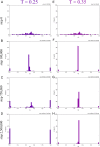Preventing extreme polarization of political attitudes
- PMID: 34876506
- PMCID: PMC8685667
- DOI: 10.1073/pnas.2102139118
Preventing extreme polarization of political attitudes
Abstract
Extreme polarization can undermine democracy by making compromise impossible and transforming politics into a zero-sum game. "Ideological polarization"-the extent to which political views are widely dispersed-is already strong among elites, but less so among the general public [N. McCarty, Polarization: What Everyone Needs to Know, 2019, pp. 50-68]. Strong mutual distrust and hostility between Democrats and Republicans in the United States, combined with the elites' already strong ideological polarization, could lead to increasing ideological polarization among the public. The paper addresses two questions: 1) Is there a level of ideological polarization above which polarization feeds upon itself to become a runaway process? 2) If so, what policy interventions could prevent such dangerous positive feedback loops? To explore these questions, we present an agent-based model of ideological polarization that differentiates between the tendency for two actors to interact ("exposure") and how they respond when interactions occur, positing that interaction between similar actors reduces their difference, while interaction between dissimilar actors increases their difference. Our analysis explores the effects on polarization of different levels of tolerance to other views, responsiveness to other views, exposure to dissimilar actors, multiple ideological dimensions, economic self-interest, and external shocks. The results suggest strategies for preventing, or at least slowing, the development of extreme polarization.
Keywords: agent-based models; democracy; ideology; opinion change; political polarization.
Conflict of interest statement
The authors declare no competing interest.
Figures









Comment in
-
The complexity of polarization.Proc Natl Acad Sci U S A. 2022 Apr 26;119(17):e2115019119. doi: 10.1073/pnas.2115019119. Epub 2022 Apr 21. Proc Natl Acad Sci U S A. 2022. PMID: 35446616 Free PMC article. No abstract available.
-
Reply to de Marchi: Modeling polarization of political attitudes.Proc Natl Acad Sci U S A. 2022 Apr 26;119(17):e2202863119. doi: 10.1073/pnas.2202863119. Epub 2022 Apr 21. Proc Natl Acad Sci U S A. 2022. PMID: 35446618 Free PMC article. No abstract available.
References
-
- Mason L., A cross-cutting calm: How social sorting drives affective polarization. Publ. Opin. Q. 80, 351–377 (2016).
-
- Patty J. W., E. M. Penn, Are moderates better representatives than extremists? A theory of indirect representation. Am. Pol. Sci. Rev. 113, 743–761 (2019).
-
- Madison J., “Federalist No. 10” in The Federalist Papers, Rossiter C., Ed. (New American Library, New York, 1961), pp. 77–84 (1787).
-
- Levitsky S., Ziblatt D., How Democracies Die (Crown, 2018).
-
- Iyengar S., Lelkes Y., Levendusky M., Malhotra N., Westwood S. J., The origins and consequences of affective polarization in the United States. Annu. Rev. Polit. Sci. 22, 129–146 (2019).
Publication types
LinkOut - more resources
Full Text Sources
Miscellaneous

